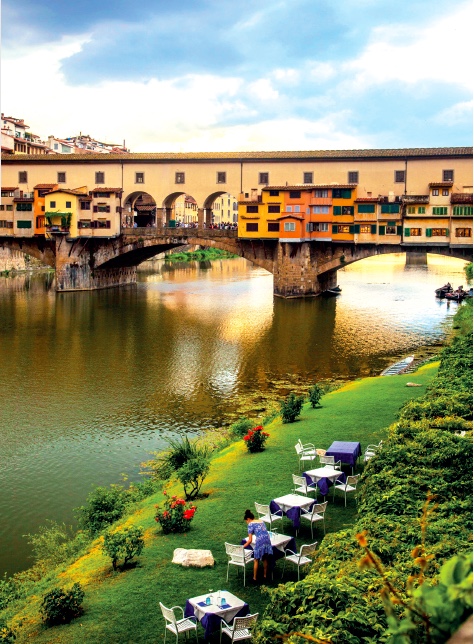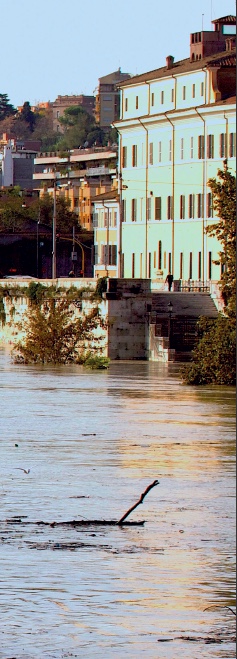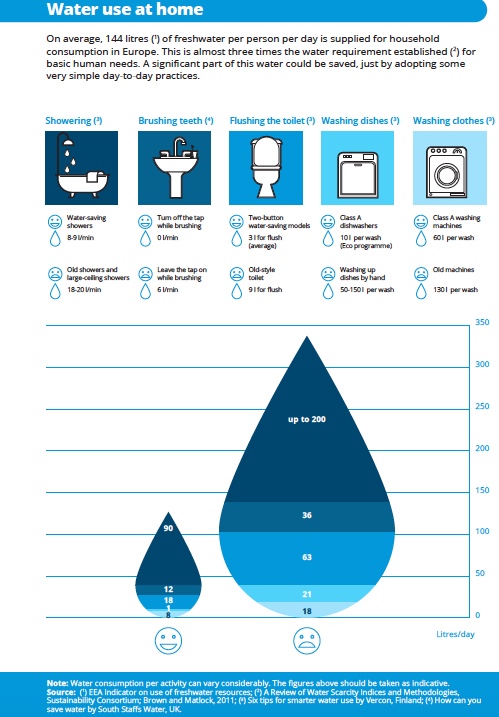We often take a reliable supply of clean water for granted. We turn on the tap and clean water comes out, we use it and the ‘dirty’ water goes down the drain. For a large majority of Europeans, the water we use at home is of drinking quality and available 24 hours a day. The brief moment between the tap and the drain is only a very small part of its overall journey. Managing water in a city is not limited to public water systems. Climate change, urban sprawl and alterations to river basins can all lead to more frequent and damaging floods in cities, leaving authorities faced with an ever-growing challenge.
Throughout history, people settled and built towns close to rivers or lakes. In most cases, streams brought clean water and took away pollution. As a city grew, its overall demand for clean water and discharge of polluted water grew along with it. In the Middle Ages, most European rivers flowing through a city served as a natural sewerage system. Following industrialisation from the 18th century onwards, rivers also started receiving pollutants released by industry. Those who did not have access to a well had to fetch water from the river — a cumbersome daily task mostly done by women and children.

© D. Aydemir/EEA
Sewage running down the streets and higher population density meant that diseases spread very quickly and could have devastating impacts on a city — on both its population and its economy. A healthy city meant a healthy workforce, which was essential for economic prosperity. Given this, investing in a public water system not only addressed health concerns arising from water contamination, but also eliminated the economic losses due to sickness in the labour force — as well as freeing up the time previously spent on fetching water.
Such public services are nothing new. The recognition that access to clean water is fundamental to public health and quality of life goes back thousands of years. About 4 000 years ago, ancient Minoans in Crete used underground clay pipes for water supply and sanitation, as well as a flushing toilet (62), as discovered during the Knossos palace excavations. Other ancient civilisations across the world built similar sanitation facilities as their cities grew and faced similar concerns.
Today, the importance of access to clean water and sanitation is embedded in the United Nations’ Sustainable Development Goals, more concretely in Goal 6 (63), ‘Ensure availability and sustainable management of water and sanitation for all’. European countries fare relatively well in this domain. In most European countries, more than 80% (64) of the total population is connected to a public water supply system.
Ever-increasing demands
Despite the investments in infrastructure and improvements in technology, managing a city’s water (65) — both the inflow and the outflow — remains a task as complex as before but with some new challenges.

© EEA
In many cities, the challenge is a question of sheer numbers. More people need and use more water. Today, about three quarters of Europe’s population lives in cities and urban areas. Some of these cities have millions of inhabitants in a relatively small area. In the past, the size of a city depended mainly on the availability of water resources nearby. Many cities in Europe, including Athens, Istanbul and Paris, currently tap into remote water sources, sometimes 100-200 kilometres away. This diversion of water can have negative impacts on the ecosystems dependent on that river or lake.
Depending on the size of the public supply network, the task of supplying clean water and collecting waste water requires a network of pumping stations, which can use large quantities of energy. If this electricity is generated by power plants using fossil fuels such as coal and oil, public water networks could be responsible for significant amounts of greenhouse gas missions and thus contribute to climate change.
The water for the public supply network needs to be of a higher quality than that for any other sector, as it is used for drinking, cooking, showering and cleaning clothes or dishes. On average, 144 litres (66) of freshwater per person per day is supplied for household consumption in Europe, excluding recycled, reused or desalinated water. This is almost three times the water requirement established (67) for basic human needs. Unfortunately, not all of the water supplied ends up being used.
Tackling leaks and ‘lost’ water
Modern public water networks consist of endless pipes and pumping systems. And, over time, pipes crack and the water leaks out. As much as 60 % of the water (68) distributed can be ‘lost’ through leaks in the distribution network. A 3-millimetre wide hole in a pipe can lead to a loss of 340 litres of water per day — roughly equivalent to a household’s consumption. Tackling leaks can result in substantial water savings. In Malta, for example, current municipal water use is about 60 % of its 1992 level and this impressive reduction was achieved mainly through leakage management.
Water is also wasted at the end of the pipe. Authorities and water companies can adopt various approaches (69), including water pricing policies (e.g. imposing levies or tariffs on water use), encouraging the use of water‑saving devices (e.g. on shower heads or taps, on toilet flushes) or education and awareness campaigns.
A combination of measures — pricing policies for saving water, reducing leakage, installing water-saving devices and more efficient household appliances — could help save up to 50 % of the water abstracted. Consumption could be reduced (70) to 80 litres per person per day across Europe.
These potential gains are not limited to the amount of water available. More importantly, saving water also saves the energy and other resources used in extracting, pumping, transporting and treating the water.
Urban waste water treatment
When it leaves our homes, water is contaminated by waste and chemicals, including phosphates used in cleaning products. The waste water is first collected in a sewage collection system and then treated at a designated facility (71) to remove components harmful to the environment and human health.
Like nitrogen, phosphorus works as a fertiliser. Excess amounts of phosphates in water bodies can lead to excessive growth of certain aquatic plants and algae. This depletes the oxygen in water, suffocating other species. Recognising these impacts, EU legislation set strict limits on the phosphorus content of various products, including household detergents, which has resulted in substantial improvements in recent decades.
The proportion of households connected to waste water treatment facilities varies across Europe. In central Europe (Note 1), for example, the connection rate is 97 % (72).
In southern, south‑eastern and eastern European countries, it is generally lower, although it has increased over the last 10 years to reach about 70%. Despite these significant improvements in recent years, around 30 million people are still not connected to waste water treatment plants in Europe. Not being connected to a collective treatment plant does not necessarily mean that all their waste water is released into the environment without treatment. In sparsely populated areas, the costs of connecting houses to a collective treatment plant could be significantly larger than the overall benefits and the sewage from those houses can be treated in small-scale installations and managed well.
After being properly cleaned, used water can be returned to nature, where it may replenish rivers and groundwaters. However, even the most advanced treatment plants can fail to completely remove some pollutants — in particular the micro- and nanoplastics often used in personal care products. Nevertheless, recent EEA analysis shows that rivers and lakes located in European cities (73) and towns are getting cleaner, thanks to improvements in waste water treatment and restoration projects.
An alternative is to directly reuse the water after it has been treated, but so far only about 1 billion cubic metres of treated urban waste water (74) is reused annually, which corresponds to approximately 2.4 % of the treated urban waste water effluent or to less than 0.5 % of annual EU freshwater withdrawals. Recognising the potential benefits of reusing water, the European Commission proposed in May 2018 new rules to stimulate and facilitate water reuse (75) in the EU for agricultural irrigation.
Mass tourism in times of climate change
There is also the question of managing extra demand. Many European capitals and coastal cities are popular tourist destinations. To illustrate the scale of this challenge, consider the example of the greater Paris region. In 2017 (76), public authorities were tasked with providing clean water and treating waste water not only for 12 million locals, but also for close to 34 million tourists. In fact, tourists account for around 9 % (77) of total annual water use in Europe.
In some cases, a combination of factors can be at play. Barcelona is a city of around 1.6 million inhabitants in a naturally water‑stressed area. According to the Barcelona City Hall, 14.5 million tourists visited the city in 2017. Several consecutive years of severe drought triggered an unprecedented water crisis in 2008. Ahead of the summer season, the city’s reservoirs were only 25 % full. In addition to public awareness campaigns and drastic cuts in consumption, Barcelona was forced to import water from other parts of Spain and France. In May, ships transporting freshwater started to unload their precious cargo at the harbour.
Many measures have been taken since. The city has invested in desalination plants, is investing in reused water and has devised a water-saving plan. Despite these measures, water shortage still continues to threaten Barcelona and spark public debate, and rightly so. Climate change projections for the Mediterranean region anticipate more extreme heat events and changes in precipitation levels. In other words, many Mediterranean cities will have to cope with more heat and less water.

© Flavio Gazzani, Water/EEA
Coping with too much water
Not having enough water can be bad enough, but having too much of it can be disastrous. In 2002, Prague suffered devastating floods, in which 17 people lost their lives and 40 000 had to be evacuated. The total damage to the city amounted to EUR 1 billion (78). Since that disastrous event, the city has invested a lot in developing a more robust flood defence system, based mostly on ‘grey infrastructure’ — concrete‑based artificial structures, such as fixed and mobile barriers and safety valves in the canalisation network along the Vltava River. The estimated total cost of these measures amounted to EUR 146 million up to 2013, but a cost-benefit analysis showed that the benefits would be greater than the costs, even if only one event like that of 2002 were to occur in the next 50 years.
Prague is not an isolated case of a city threatened by river flooding. In fact, as a rough estimate, 20 % of European cities (79) face that danger. Soil sealing in urban areas (i.e. covering the ground with infrastructure such as buildings, roads and pavement) and conversion of wetlands for other purposes reduce nature’s ability to absorb excess water and thus increase cities’ vulnerability to floods. Although it has been used for centuries, grey infrastructure can sometimes be insufficient and even damaging, especially as climate change brings more extreme weather that may lead to high flood levels. Moreover, it is very costly and might increase the risk of flooding downstream. Working with natural landscape elements (often referred to in policy circles as ‘nature-based solutions’ and ‘green infrastructure’), such as floodplains and wetlands, can be cheaper, easier to maintain and certainly more environmentally friendly.
Another city where too much water has caused trouble in the past is Copenhagen. This time, it was not river flooding but heavy rain. Four major rainfall events have caused havoc in Copenhagen in recent years, the largest in 2011, when the cost of the damage soared to EUR 800 million. Adopted in 2012, the Cloudburst Management Plan (80) for Copenhagen assessed the costs of various measures. Further investment in the sewerage network alone would not solve the problems, as the investment required would be very high and the city would still be flooded. According to the plan, a combination of traditional ‘grey infrastructure’ and nature‑based solutions would work best. In addition to an extension of the Copenhagen sewerage network, around 300 projects are being implemented up until 2033, focusing on improved water retention and drainage. These include providing more green spaces, reopening streams, constructing new canals and establishing lakes.
Be it ensuring a reliable clean water supply, treating waste water or preparing for floods or scarcity, it is clear that managing water in a city requires good planning and foresight.

Note 1. For the purposes of these estimates, the following groupings are used: central European countries refer to Austria, Belgium, Denmark, Germany, Luxembourg, Netherlands, Switzerland and the United Kingdom; southern European countries refer to Greece, Italy, Malta and Spain; south-eastern European countries refer to Bulgaria, Romania and Turkey; and eastern European countries refer to the Czech Republic, Estonia, Hungary, Latvia, Lithuania, Poland and Slovenia.
Footnotes
- www.nature.com/news/the-secret-history-of-ancient-toilets-1.19960
- sustainabledevelopment.un.org/sdg6
- www.eea.europa.eu/data-and-maps/indicators/use-of-freshwater-resources-2/assessment-3
- www.eea.europa.eu/publications/rivers-and-lakes-in-cities
- www.eea.europa.eu/data-and-maps/indicators/use-of-freshwater-resources-2/assessment-3
- oamk.fi/~mohameda/materiaali16/Water %20and %20environmental %20management %202015/2011_Brown_Matlock_Water-Availability-Assessment-Indices-and-Methodologies-Lit-Review.pdf
- 68.www.who.int/water_sanitation_health/hygiene/plumbing18.
- www.eea.europa.eu/themes/water/water-management/water-management-in-europe
- www.eea.europa.eu/data-and-maps/indicators/urban-waste-water-treatment/urban-waste-water-treatmentassessment-4
- www.eea.europa.eu/data-and-maps/indicators/urban-waste-water-treatment/urban-waste-water-treatmentassessment-4
- www.eea.europa.eu/highlights/restoring-european-rivers-and-lakes
- ec.europa.eu/environment/water/reuse.htm
- ec.europa.eu/environment/water/reuse.htm
- www.europe1.fr/economie/nombre-record-de-touristes-en-2017-pour-paris-et-sa-region-3581510
- www.eea.europa.eu/data-and-maps/indicators/use-of-freshwater-resources-2/assessment-3
- climate-adapt.eea.europa.eu/metadata/case-studies/realisation-of-flood-protection-measures-for-thecity-of-prague
- www.eea.europa.eu/publications/green-infrastructure-and-flood-management/#page=11
- climate-adapt.eea.europa.eu/metadata/case-studies/the-economics-of-managing-heavy-rains-andstormwater-in-copenhagen-2013-the-cloudburst-management-plan
This Commentary was originally published by the European Environment Agency (EEA) as a chapter in Signals 2018 – Water is life: Europe’s rivers, lakes and seas are under pressure from pollution, over-exploitation and climate change. How can we ensure a sustainable use of this vital resource? www.eea.europa.eu/signals/


No comments yet, add your own below